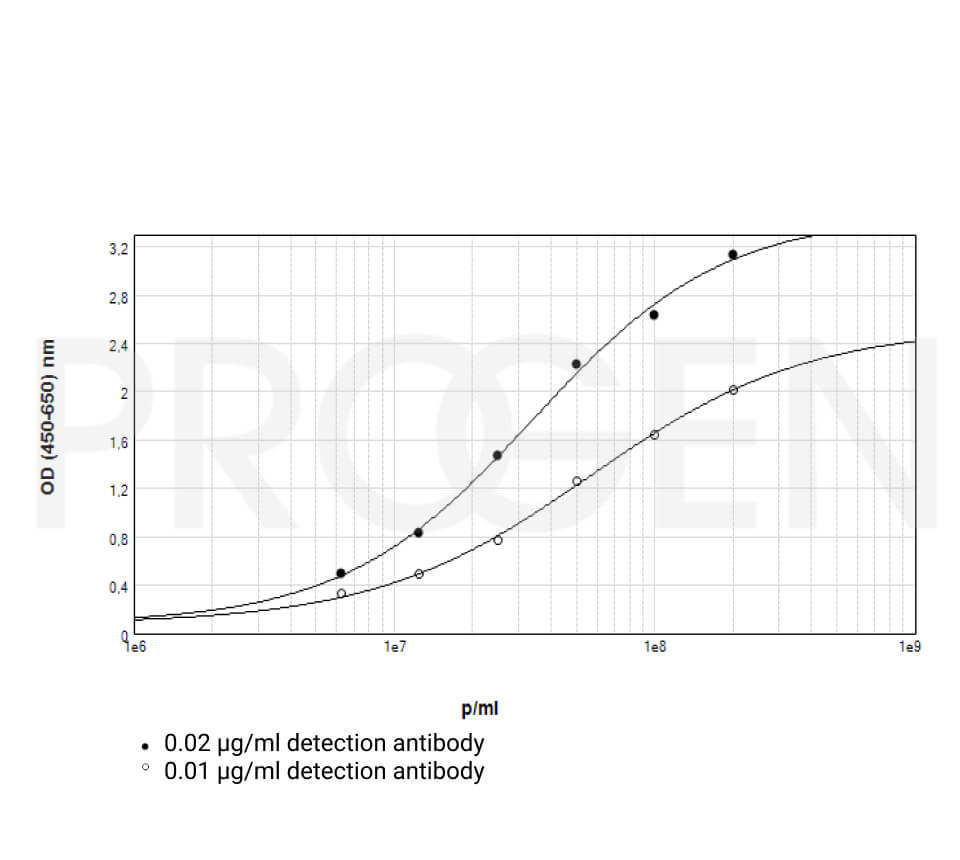pSEX81 Surface Expression Phagemid Vector
Phagemid cassette vector for the expression of functional recombinant single-chain Fv antibody - pIII fusion protein libraries on the surface of M13 filamentous phage using a E. coli lacIq genotype (e.g. XL1-Blue) host.
Product description
| Quantity | 5 µg |
|---|---|
| Host | E. coli lacIq genotype (e.g. XL1-Blue) |
| Purification | Plasmid Purification Kit |
| Storage | -20°C |
| Intended use | Research use only |
| Concentration | 0.5 µg/µl in TE buffer |
| Purity | OD 260/280 ratio: 1.8-2.0 |
| Quality check | Efficiency in standard transformation procedure with chemically competent E. coli cells (XL1-Blue) > 1E+08 cfu/µg DNA |
| Stability | Minimum 1 year when stored at -20°C |
| Vector | 4883 bp, AmpR |
| Cloning sites | MluI and NotI for light chain VL genes, NcoI and HindIII for heavy chain VH genes |
| Note | For plating we recommend to use LB Agar plates containing 100 mM Glucose |
Background
Introduction
Within the past decade, recombinant antibody technologies have been widely used to produce various single-chain Fv antibody fragments of different specificity. The randomized combination of PCR-amplified immunoglobulin variable heavy and light chain genes further led to the construction of large human or mouse scFv antibody libraries. The isolation of high affinity antibodies derived thereof was established by the expression of recombinant antibody fragments on the surface protein pIII of M13 bacteriophages, which can be rapidly screened against antigens bound to a solid phase.
The M13 bacteriophage protein pIII is located at one end of its tubular virion structure. It is a relative flexible and accessible molecule composed of two functional domains: an N-terminal domain that binds to the F pilus of bacteria during infection and a C-terminal domain buried within the virion. ScFv antibody fragments can be inserted near its N-terminus without destroying its function.
PROGEN now offers the phagemid cassette vector pSEX81 for the expression of functional single-chain Fv antibody - pIII fusion proteins on the surface of M13 bacteriophages. The phagemid was specifically constructed for cloning of immunoglobulin heavy and light chain gene fragments isolated from human or mouse antibody libraries generated with PROGEN's PCR primer sets F2000 or F2010.
Vector Design
The cassette vector pSEX81 was designed for the convenient insertion of heavy and light chain variable domain coding regions and for production of functional single-chain Fv antibody - pIII fusion proteins on the surface of M13 bacteriophages. The corresponding DNA fragments of human or mouse origin can be amplified by PCR using PROGEN's primer sets F2000 or F2010, respectively. The amplified gene fragments encoding the variable heavy or light chain domain are cloned in-frame between a signal peptide sequence of bacterial pectate lyase (pelB) for the secretion of the fusion protein into the periplasmic space, and the pIII gene of M13 bacteriophage. The VH and VL genes were joined by a DNA-fragment coding for a flexible 18 amino acid residue linker containing the first six amino acids of the CH1 constant region domain and the hydrophilic pig brain alpha-tubulin peptide sequence EEGEFSEAR. The vector backbone further provides a strong promotor, the T7 terminator, the ColE1 origin of replication, the intergenic region of phage F1 and an ampicillin resistance marker for selection.
In pSEX81 the recognition sites of the restriction endonucleases Nco I and Hind III allow the insertion of a VH gene fragment. For insertion of a VL gene fragment the sites of the restriction endonucleases Mlu I and Not I are recommended.
Material Required
Equipment for DNA cloning
Preparation of Reagents
The DNA should be diluted and transfered into E. coli cells as described in standard protocols. Use an overnight culture of a single clone to extract enough DNA for the following cloning procedures.
Cloning procedure
The immunoglobulin heavy and light chain Fv domain coding regions must be cloned in-frame into pSEX81 (see attached graphic). To clone VH gene fragments the recognition sites of the restriction endonucleases Nco I and Hind III are recommended. VL gene fragments should be introduced by using the recognition sites of the enzymes Mlu I and Not I. The cloning sites of the selected Fv gene fragments have to match the corresponding amino acid positions given by the vector. Gene fragments derived from human or mouse origin with PROGEN's PCR primer sets F2000 or F2010 can be directly cloned into pSEX81.
After cloning, the vector is ready-to-use for the expression of functional recombinant single-chain Fv antibody - pIII fusion proteins in E. coli. If the modified pSEX81 is co-transfected with M13 bacteriophage as described in standard protocols (Schmiedl et al., 2000; Schmiedl and Duebel, 2001), the scFv antibody - pIII fusion protein is expressed on the surface of resulting phage particles. For expression of scFv antibody libraries on the surface of M13 bacteriophages, we recommend to use the M13 Hyperphage from PROGEN (Cat. No. PRHYPE).
References/Publications (12)
Downloads
Q & A's
Customer Reviews
Login
FAQs
DH5alpha or TOP10 (without F episome) are lacIq negative and therefore the toxic proteins are expressed in these cells. When using lacIq negative cell lines with the pSEX81 vector you will receive only a few colonies and most often the plasmid is somehow mutated in these colonies.
We also recommend to include 100 mM Glucose to the culture medium to avoid possible mutations of the plasmid.
Only vectors coding for a fully functional PIII protein are suitable for the hyperphage system, for example pSEX81.
According to the literature pCANTAB vector is compatible with hyperphage, although with lower efficiency as for example pSEX81 (https://www.ncbi.nlm.nih.gov/pmc/articles/PMC1866265/).







